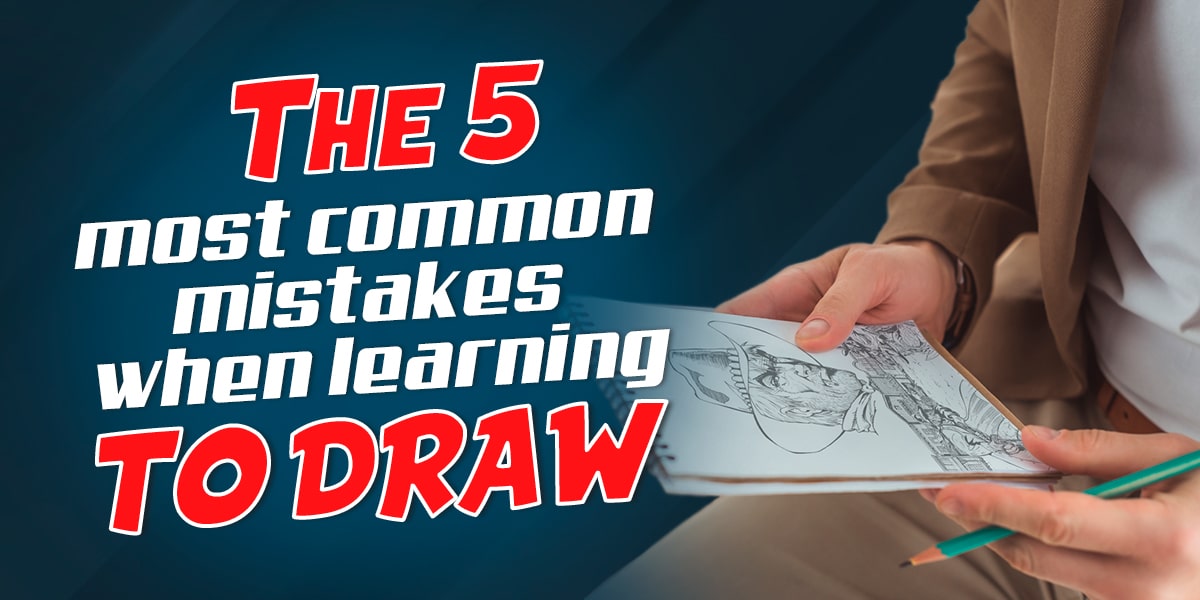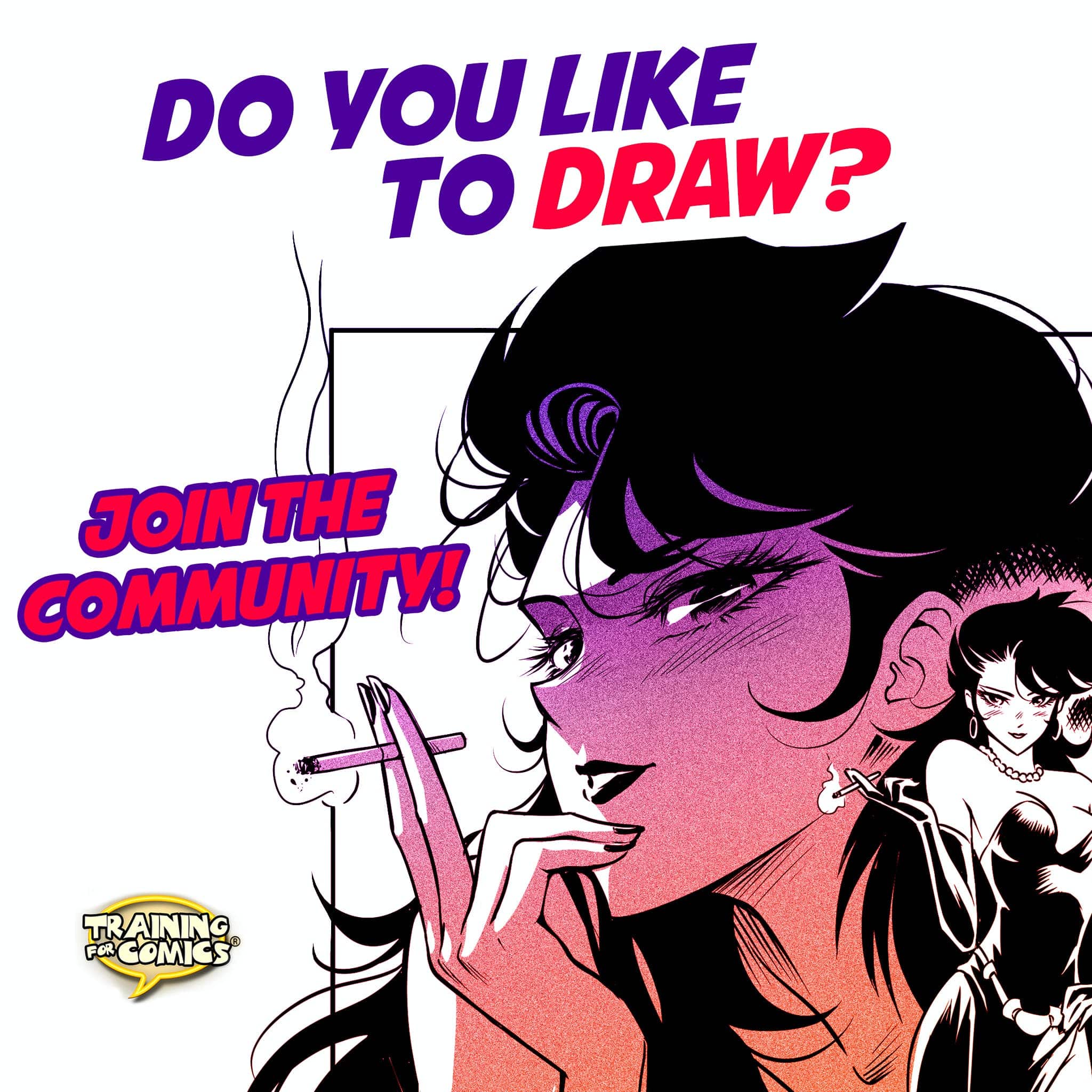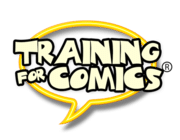The 5 Most Common Mistakes When Learning to Draw
Have you ever felt that your drawings aren’t progressing as you expected? Do you get frustrated seeing that your strokes don’t reflect what you have in mind? You’re not alone. Many beginner artists face similar challenges on their path to mastering drawing. In this article, we’ll unravel the 5 most common mistakes aspiring artists make and provide you with valuable tips to overcome them.
Get ready to discover how small adjustments in your approach can dramatically transform your creations. Whether you dream of mastering manga, perfecting your portraits, or creating fantastic worlds, these tips will help you avoid common obstacles and unlock your true artistic potential. Keep reading and take the first step towards a new stage in your creative journey!
The Fascinating World of Drawing and Illustration
When we immerse ourselves in the universe of drawing, we find a vast ocean of creative possibilities. It’s natural to feel overwhelmed by the diversity of styles, techniques, and masters who have left their mark on art. Perhaps you’ve marveled at the intricate details of a manga, or maybe you’ve been captivated by the expressiveness of a charcoal portrait. Whatever your inspiration, the desire to reach those artistic heights can be as motivating as it is challenging.
In the digital age, we have access to an unprecedented amount of resources to learn how to draw. From video tutorials to e-books, online courses, and artist communities, the options are virtually endless. This abundance of information can be a blessing, but also a double-edged sword if we don’t know how to use it correctly.
The truth is that, regardless of the style that captivates us or the technique we long to master, there are certain fundamental principles that every artist must know and practice. These fundamentals are the foundation upon which any masterpiece is built, whether it’s a superhero comic, a fantasy illustration, or a hyperrealistic portrait.
However, in our eagerness to progress quickly, it’s easy to fall into counterproductive habits that can hinder our artistic development. These “mistakes” are as common as they are detrimental, and the sooner we identify and correct them, the smoother our path to excellence in drawing will be.
Next, we’ll explore in detail the five most frequent mistakes beginners make in the art of drawing. But don’t worry, we won’t just point out these common stumbling blocks; we’ll also provide you with practical strategies to overcome them. Are you ready to take your artistic skills to the next level? Discover how to perfect your technique here and prepare to see a notable improvement in your creations.
The 5 Most Common Mistakes of Beginners: Pay Attention, Correcting Them in Time Will Notably Improve Your Drawings!
1. The Perfectionist’s Error: Not Sketching
One of the most frequent and detrimental mistakes novice artists make is skipping the sketching phase. It’s understandable: when we have a brilliant idea in mind, we want to put it on paper as quickly as possible, with all its details and perfection. However, this approach often leads to frustration and disappointing results.
The sketch is the skeleton of your work, the structure on which you’ll build your final creation. Ignoring this crucial step is like trying to build a house without foundations. You might manage to put up some walls, but sooner or later, everything will come crashing down.
What Does Sketching a Drawing Really Mean?
Sketching isn’t about creating a perfect draft of your final idea. It’s a process of exploration and visual planning. When you sketch, you are:
- Exploring different compositions and angles
- Establishing the basic proportions of elements
- Defining the overall structure of your drawing
- Experimenting with the position and flow of elements
A good sketch allows you to visualize your general idea and make adjustments before committing to details. It’s like a map that guides you through the creation process, allowing you to identify and solve composition, proportion, and design problems from the start.
Skipping sketching can lead to frustrating situations, such as realizing at the end that the proportions are wrong, the composition doesn’t work, or you’ve forgotten important elements. Imagine decorating a room and buying all the furniture without measuring the space first. The result could be chaotic and costly to correct.
To improve your sketching skills, click here and discover practical exercises that will help you master this essential technique. Remember, a good sketch is the foundation of a great work of art.

2. The Detail Trap: Going Straight to a Single Element
Once past the sketching phase, many artists fall into another common trap: obsessively focusing on a single detail of the drawing, neglecting the rest of the composition. It’s understandable to feel the urge to immediately perfect the part that excites us most, but this approach can throw off balance our entire work.
Imagine you’ve sketched an epic scene: a vast landscape with a heroic character in the foreground. It’s tempting to dive right into the details of the protagonist’s face, seeking to capture that intense and determined look you’ve visualized. However, by concentrating exclusively on the eyes or features, you risk neglecting crucial elements such as body proportion, the character’s relationship to the environment, or the overall atmosphere of the scene.
The Danger of Unbalanced Focus
When we focus prematurely on details, we can:
- Lose the overall coherence of the composition
- Create disproportion between different parts of the drawing
- Neglect important background or context elements
- Exhaust our creative energy on a single area, leaving the rest of the work without the same level of attention
The key is to develop a holistic approach, working on the entire image in a balanced way. This doesn’t mean you can’t dedicate more time to certain areas, but that you should do so consciously and in a planned manner, without losing sight of the whole.
Strategies for Balanced Development
To avoid falling into the premature detail trap, consider these strategies:
- Develop the main elements simultaneously, alternating between them.
- Establish progressive levels of detail for the entire image, gradually refining each area.
- Use the squinting technique to regularly evaluate tonal relationships and overall composition.
- Take frequent breaks to observe your work from different distances and angles.
Remember, an exceptional drawing isn’t just about perfect detail, but how all elements harmonize to create a cohesive and captivating work. Want to learn how to balance details and composition? Explore advanced techniques here and take your illustrations to the next level.
3. Creative Rigidity: Stiffening the Hand
One of the most subtle but significant obstacles beginner artists face is the tendency to stiffen the hand and wrist while drawing. This habit, though seemingly harmless, can have a profound impact on the quality and fluidity of your strokes, limiting your artistic expression and causing unnecessary fatigue.
When we start drawing, it’s natural to want to control every aspect of our stroke. Unconsciously, we grip the pencil tightly, tense the muscles in our hand and wrist, believing this will give us more precision and control. However, this excessive tension produces the opposite effect: rigid lines, shaky strokes, and a loss of naturalness in our drawings.
The Negative Effects of a Tense Hand
- Rigid and unnatural lines
- Difficulty creating fluid and expressive strokes
- Quick fatigue of the hand and arm
- Limitation in the variety of strokes and textures
- Possible development of long-term health issues (such as carpal tunnel syndrome)
How to Achieve a Fluid and Natural Stroke
The key to overcoming this mistake is learning to relax your hand and trust in the natural fluidity of your movement. Here are some techniques to achieve this:
- Practice warm-up exercises: Before you start drawing, do some simple exercises to relax your hand and wrist.
- Adjust your grip: Experiment with different ways of holding your drawing tool. A looser grip can provide greater freedom of movement.
- Draw from the shoulder: For longer and more fluid strokes, try moving your entire arm from the shoulder instead of just the wrist.
- Vary the pressure: Practice applying different levels of pressure to create variety in your lines.
- Perform stroke exercises: Dedicate time to practicing different types of lines and curves without worrying about creating a specific image.
Remember, the goal is not to have absolute control over every millimeter of your stroke, but to develop a fluid connection between your creative mind and your hand. Ready to free your stroke? Discover specific exercises here and experience the freedom of looser and more expressive drawing.

4. The Quest for Perfection: The Single, Infallible Line
Following the line of the previous error, we encounter another common habit among novice artists: the obsession with finding and executing the “perfect line” in every stroke. This quest for immediate perfection can be paralyzing and counterproductive, limiting creative exploration and the natural evolution of the drawing.
Many beginners believe that experienced artists create their works with precise and definitive lines from the very beginning. However, the reality is very different. The most impressive drawings are often the result of a gradual construction process, where lines overlap, adjust, and are continuously refined.
The Myth of the Perfect Line
The belief in a single, perfect line can lead to:
- Fear of making mistakes, which inhibits experimentation
- Frustration when not achieving “perfect” results immediately
- Rigidity in style and lack of expressiveness
- Excessive time dedicated to premature details
- Difficulty in developing a fluid personal style
Embracing the Beauty of Multiple Lines
Instead of seeking perfection in every stroke, it’s more productive and liberating to embrace the beauty of multiple, overlapping lines. This approach allows you to:
- Explore shapes and contours: Use light and loose lines to search for the correct form without commitment.
- Build volume and depth: Overlapping lines can create texture and bring your drawings to life.
- Develop your personal style: The way your lines interact can become a distinctive feature of your art.
- Improve fluidity: By not worrying about immediate perfection, your strokes become more natural and expressive.
- Facilitate corrections: It’s easier to adjust and refine when working with multiple light lines.
To adopt this freer and more expressive approach, try these techniques:
- Start with very soft and light strokes, almost imperceptible.
- Overlap several lines to find the desired shape.
- Vary the pressure and speed of your strokes to create dynamism.
- Don’t erase “incorrect” lines; use them as a guide to refine your drawing.
- Practice gestural drawing to quickly capture the essence of forms.
Remember, the drawing process is as important as the final result. Want to free your style and find your unique artistic voice? Explore innovative techniques here and discover how imperfection can be your ally in creating memorable art.
5. Tunnel Vision: Losing Perspective
The last common mistake, but no less important, is what we could call “tunnel vision” or the tendency to focus too much on details without stepping back to evaluate the whole. This habit can lead to losing the global perspective of your work, resulting in unbalanced compositions or disproportionate elements.
When we immerse ourselves deeply in our work, it’s easy to get trapped in small details. We spend hours perfecting a texture or shading, only to realize, in the end, that something doesn’t fit in the whole. This lack of perspective can be frustrating and costly in terms of time and effort.
The Dangers of Tunnel Vision
- Loss of global coherence in the composition
- Disproportion between different elements of the drawing
- Overload of details in areas that don’t require it
- Lack of harmony in the use of tones and values
- Creative exhaustion from focusing too much on specific areas
Strategies to Maintain a Global Vision
To avoid falling into the tunnel vision trap, consider implementing these practices:
- Take regular breaks: Step away from your work every 20-30 minutes to evaluate it from a distance.
- Use a mirror: Observe your drawing reflected in a mirror to detect composition or proportion problems.
- Rotate your work: Turn your drawing 180 degrees to see it from a new perspective.
- Squinting technique: Squint your eyes to evaluate tonal values and overall composition.
- Photograph your progress: Take photos of your work at different stages to have an objective view of its evolution.
- Ask for opinions: Share your work in progress with other artists or friends to get fresh feedback.
Maintaining a balanced vision between details and the whole is crucial for creating coherent and attractive works. Ready to elevate your artistic perspective? Discover advanced tools and techniques here and learn to evaluate and improve your creations holistically.
Conclusion: Transforming Mistakes into Growth Opportunities
Throughout this article, we’ve explored the five most common mistakes beginner artists face in their creative journey. From omitting sketching to losing global perspective, each of these challenges represents a unique opportunity to grow and improve as an artist.
Remember, these “mistakes” are a natural part of the learning process. They are not insurmountable obstacles, but stepping stones on your ladder to artistic mastery. By identifying them and consciously working to overcome them, you’ll not only improve your technical skills but also develop a deeper understanding of your creative process.
Steps Towards Artistic Success
- Practice sketching: Make sketching an integral part of your creative process.
- Develop a holistic vision: Work on the entire composition in a balanced way.
- Cultivate relaxation: Learn to draw with a loose and fluid hand.
- Embrace imperfection: Use multiple lines to build and refine your drawings.
- Maintain perspective: Regularly evaluate your work from different angles and distances.
Implementing these changes may seem challenging at first, but with practice and patience, they will become natural habits that significantly elevate the quality of your art. Remember, every great artist has gone through this process of learning and growth.
Your artistic journey is unique and personal. Don’t be afraid to experiment, make mistakes, and learn from them. Every stroke, every sketch, and every work you create brings you one step closer to your ideal artistic vision. Are you ready to take your art to the next level? Click here to discover resources and techniques that will boost your artistic growth.
The world of art is full of infinite possibilities. With dedication, practice, and the willingness to learn from your mistakes, there’s no limit to what you can create. Grab your tools, free your imagination, and start bringing your artistic visions to life today!



